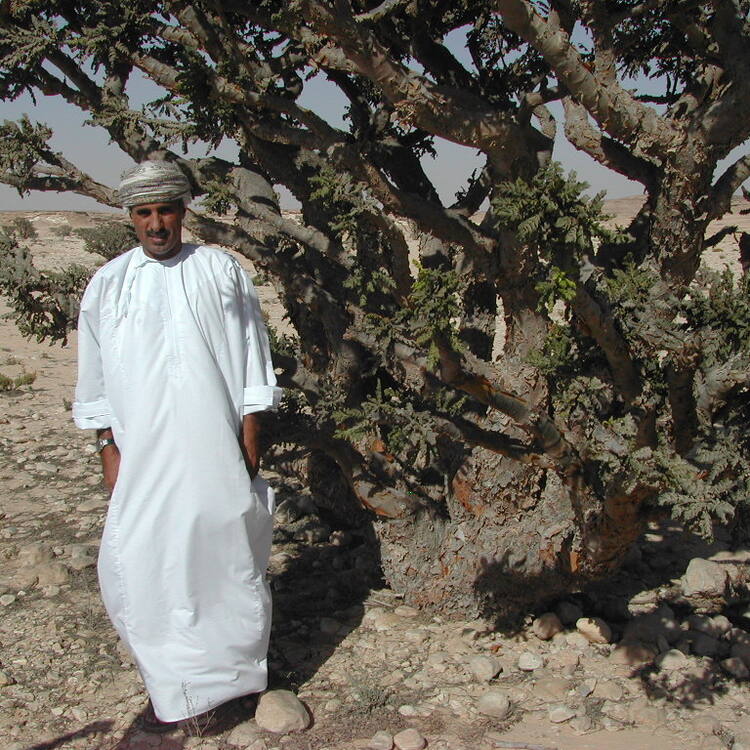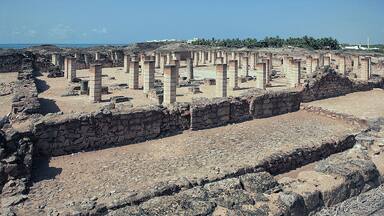Land of Frankincense
Land of Frankincense
The frankincense trees of Wadi Dawkah and the remains of the caravan oasis of Shisr/Wubar and the affiliated ports of Khor Rori and Al-Baleed vividly illustrate the trade in frankincense that flourished in this region for many centuries, as one of the most important trading activities of the ancient and medieval world.
Description is available under license CC-BY-SA IGO 3.0
Terre de l’encens
Les arbres d'encens de l'Ouadi Dawkah, les vestiges de l'oasis caravanière de Shisr/Wubar et les ports associés de Khor Rori et d'Al-Baleed illustrent de manière frappante le commerce de l'encens qui prospéra dans cette région durant de nombreux siècles et fut l'une des plus importantes activités commerciales du monde antique et médiéval.
Description is available under license CC-BY-SA IGO 3.0
أرض اللبان
تبرز أشجار اللبان في وادي دوكة، بالإضافة إلى آثار الواحة الصحراوية المتنقلة في شصر/وبار والمرافئ المرتبطة بخور روري والبليد. فقد ازدهرت تجارة اللبان بشكل واضح في هذه المنطقة خلال قرون عدة وكانت من أهم النشاطات التجارية في العالم القديم وفي القرون الوسطى.
source: UNESCO/CPE
Description is available under license CC-BY-SA IGO 3.0
乳香之路
瓦迪•道卡的乳香树和什斯尔/乌芭尔以及相关的科尔罗里和巴厘德港口的商队绿洲遗迹,都表明这里的乳香贸易繁荣了很多世纪。这项贸易在古代和中世纪是最重要的商业活动之一。
source: UNESCO/CPE
Description is available under license CC-BY-SA IGO 3.0
Древний торговый путь “Тропа ладана”
Ладанные деревья в оазисе Вади-Дауках и остатки оазиса Шист-Вубар, через который проходил караванный путь, а также порты Хор-Рори и Аль-Балид, наглядно демонстрируют, как происходила торговля ладаном, процветавшая в этом регионе многие столетия. Ладан являлся одним из важнейших товаров в древнем и средневековом мире.
source: UNESCO/CPE
Description is available under license CC-BY-SA IGO 3.0
Tierra del incienso
Los árboles de incienso del Uadi Dawkah, los vestigios del oasis de Shisr-Wubar, lugar de paso de las caravanas, y los puertos de Jor Rori y Al Baleed ilustran vívidamente el floreciente comercio secular del incienso en esta región, que fue una de las actividades económicas más importantes de la Antigüedad y la Edad Media.
source: UNESCO/CPE
Description is available under license CC-BY-SA IGO 3.0
フランキンセンスの国土
オマーン南部。ドファール地方にあるワジ・ダウカー乳香樹と、シズルの隊商オアシス跡およびコールロリとアルバリドの港は、何世紀にもわたってこの地方一帯を賑わせた乳香貿易の場である。カンラン科の樹木から採取される乳香は、最も高価な香料の一つとされる。乳香貿易は、古代および中世初期に至る時期、アラビア海周辺とその公益範囲の世界では最も重要な経済活動であった。1990年代初期に衛星写真によりこの都市遺跡が発見された。source: NFUAJ
Land van Wierook
De wierookbomen (Frankincense) van Wadi Dawkah, de overblijfselen van de oase van Shisr/Wubar en de aangesloten havens Khor Rori en Al-Baleed getuigen van een bloeiende handel in wierook gedurende vele eeuwen. Het was in deze regio een van de belangrijkste handelsactiviteiten van de oude wereld en de middeleeuwen. Deze groep van archeologische gebieden in Oman weerspiegelen de productie en distributie van wierook, een van de meest belangrijke luxe handelswaar in de oudheid, van de Middellandse en Rode Zee naar Mesopotamië, India en China. Het Land van Wierook is een bewijs van een bloeiende beschaving in Zuid-Arabië, van het neolithicum tot de late islamitische periode.
Source: unesco.nl
Outstanding Universal Value
Brief synthesis
The four components of the Land of Frankincense dramatically illustrate the trade in frankincense that flourished in this region for many centuries. They constitute outstanding testimony to the civilizations in south Arabia since the Neolithic.
The successive ports of Khor Rori (4th century BC to the 5th century AD) and Al Baleed (8th century till 16th century AD) and an outpost close to the Great Desert Rub Al Khali, Shisr, about 170 km inland, represent in a unique way the distribution of frankincense which was produced in the wadis of the coastal hinterland. All three sites were exceptionally fortified. Wadi Dawka is an outstanding example of the growth of the frankincense tree (boswellia sacra) from which the resin was produced, collected and traded.
The port of Khor Rori (the Moscha Limen of classical geographical texts) lies 40 km to the east of Salalah on a hilltop on the eastern bank of a sweet-water outlet (khor). About 400 metres from the open sea, it dominates the khor which opens to the sea and served as a natural harbour. The remains of the fortress are located on a rocky spur running east-west, forming part of a wider defensive system, details of which are still evident. The walls have dressed stone faces with rubble cores. The most heavily fortified part is on the north, where the entrance is located, itself a massive structure with three successive gates on the steep entry path. It is flanked by the remains of towers. The port was refounded at the end of the 1st century by LL'ad Yalutas (evidenced by an inscription still in situ) to control the trade in Dhofar incense. It was the hub of the trading settlements on this coast at that time. The process of disintegration began in the 5th century.
Al-Baleed, a harbor directly placed on the beaches of the Indian Ocean with a khor, a sweet water reservoir behind it, is the historically late name for the town. Artifacts from China (Ming) and other countries indicate its importance as a harbor along the ´Silk Road to the Sea´ from where, in exchange, frankincense was also traded. Though heavily fortified, the town was attacked and partially destroyed on several occasions in the 13th century. By the late 15th century, radical changes to trading patterns imposed by Portuguese and other European trading nations sealed the fate of the town.
Shisr lies about 180 km north of Salalah in the desert. This agricultural oasis and caravan site was a very important station also for water supply on the routes from the Nejd and the hinterland from where frankincense was brought to the ports along the coast.
Wadi Dawkah is a major place where the frankincense tree (boswellia sacra) can still be found and frankincense is harvested to this day. The wadi seasonally drains the north-south mountains disappearing into the desert of the ´Empty Quarter´, the Rub al Khali. The trees grow in the alluvial bed of the wadi under the extreme heat of this region.
Criterion (iii) : The group of archaeological sites in Oman represent the production and distribution of frankincense, one of the most important luxury items of trade in the Old World in Antiquity.
Criterion (iv) : The Oasis of Shisr and the entrepots of Khor Rori and Al-Baleed are outstanding examples of medieval fortified settlements in the Persian Gulf region.
Integrity
The Land of Frankincense sites include all elements necessary to express its Outstanding Universal Value. The property is of adequate size to ensure the complete representation of the features and processes underpinning the property’s significance. All attributes of Outstanding Universal Value are fully present within the properties. All are fully present, none are eroded and the dynamic functions between them are fully maintained.
The property does not suffer from adverse effects of development and/or neglect. Due to the full protection of the sites no threats can be observed. Through protection of all four sites by the government of all sites the integrity is guaranteed. All buffer zones have been respected and no encroachment can be observed. All properties are fenced and the buffer zones marked.
Authenticity
The authenticity of the property is not open to question. Three components are archaeological sites that have had no inhabitants for centuries and the fourth is a natural site in a desert area.
Protection and management requirements
The property is protected by the Royal Decree No. 6/80 on the protection of the national heritage, and its buffer zone was given legal status by Royal Decree No. 16/ 2001. The property is managed through a Management Plan. The sites are fenced and the buffer zones are marked. In Shisr, a small settlement of the Bedouins lies within the buffer zone (radius of 700 meters from the property center). Also in Shisr the palm trees of the oasis, part of the buffer zone, will be replaced by young trees by the authority. The re-generation and maintenance of plantation schemes will be essential in the future.
Major measures have been undertaken to maintain the property’s authenticity and integrity and to protect the archaeological sites against interventions by visitors. Visitors must use only the access paths which are laid on Geo-textiles to protect the archaeological surfaces. In the ruins the stone walls of buildings have been protected with sacrificial layers of stone.
All the archaeological parks are in very good condition, and Al Baleed and Khor Rori have Visitor Interpretation Centres to manage the number of visitors (in 2014 more than 150000) and introduce them to the cultural background of the sites. An Interpretation Centre for Shisr is being planned. The Land of Frankincense sites are an integral part of a long-term sensitive cultural tourism strategy to inform regional, interregional and international visitors about the rich tradition of the Land of Frankincense.

